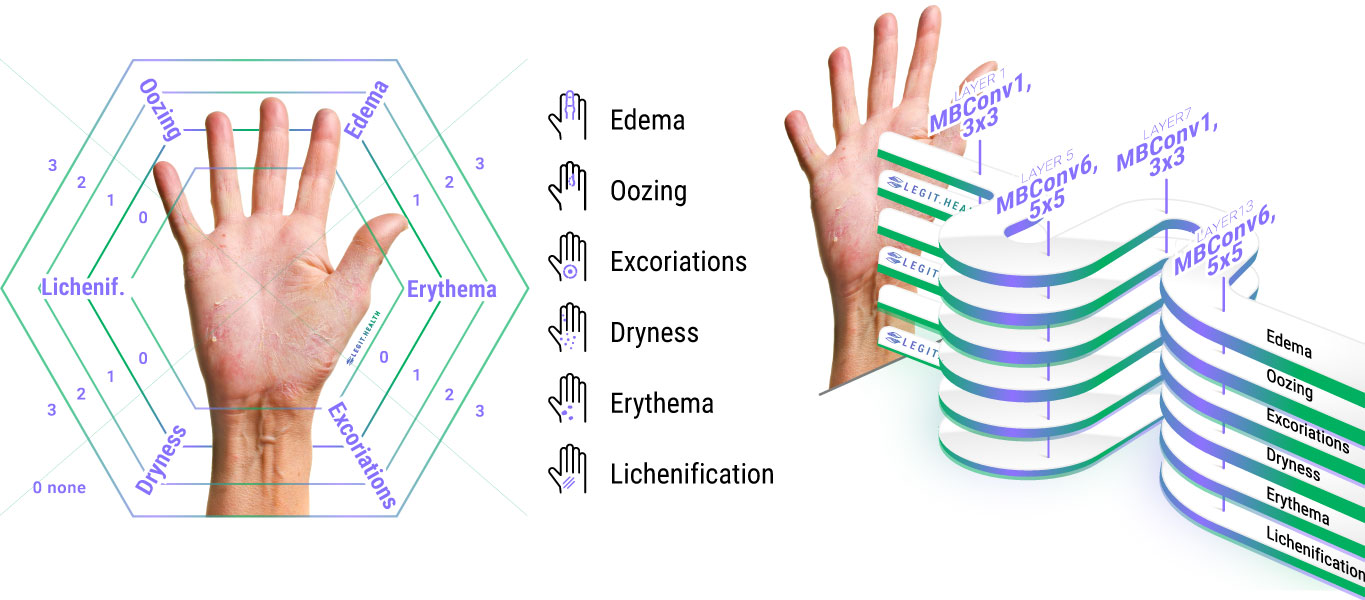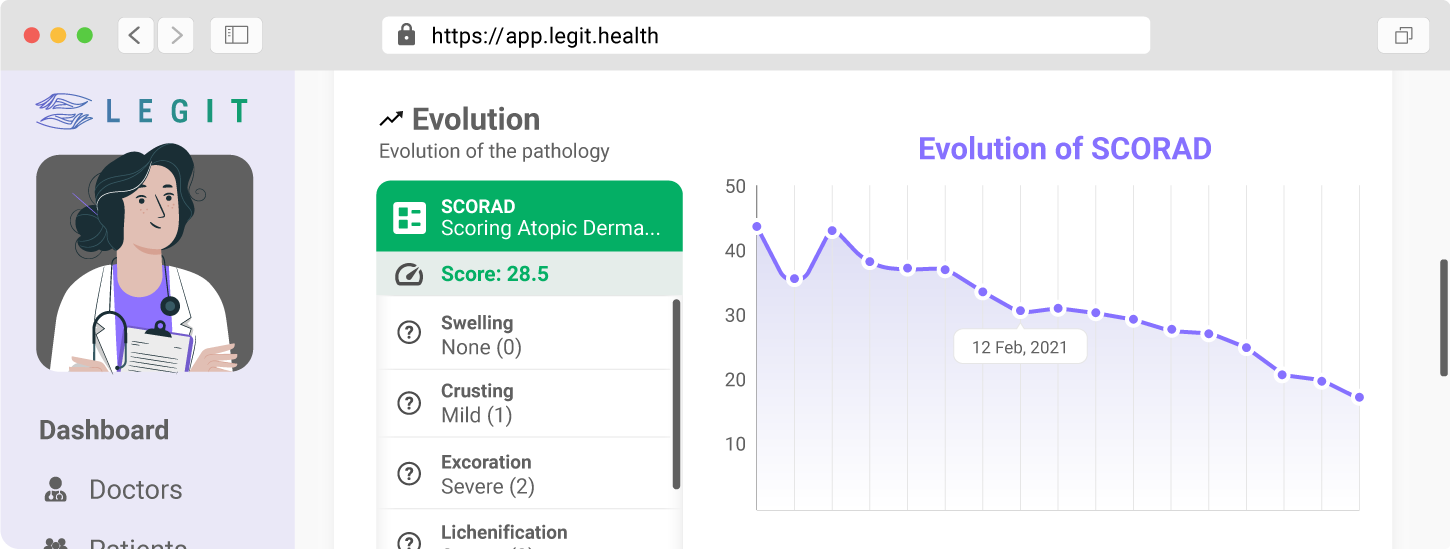What is the SCORAD?
What is the SCORing Atopic Dermatitis?
The problem that the SCORAD solves is that doctors don't have reliable diagnostic and activity markers for eczema. There is not a lab test that can practically be performed to measure the extent of the affectation of a patient. Therefore, eczema affectation can currently be measured only by the use of questionnaires, known as reported outcome measures, which are subjectively filled in.
This is especially problematic because eczema and atopic dermatitis symptoms can vary considerably, which makes it very important to be able to track changes.
The solution is the SCOring Atopic Dermatitis system, also called SCORAD. It's a tool to measure how much atopic dermatitis a patient is suffering.
The SCORAD is an established and widely accepted tool to prospectively measure eczema. It's the most used instrument to measure atopic dermatitis, both in clinical trials and in day-to-day practice. It has been used in most European clinical trials in eczema in recent years as the main outcome parameter.
Why is the SCORAD score important?
Eczema affects around 223 million people worldwide. Indeed, between 4% and 5% of the total population has eczema, of which around 43 million are aged 1 to 4 according to the International Eczema Council. Atopic dermatitis affects people's quality of life. It affects day-to-day activities and work productivity, and has negative effects on people's sleep, and emotional and psychological well-being. The burden of eczema on patients, their families and friends, the health care system and society is substantial.
When a doctor prescribes a treatment for a patient with eczema the severity of the disease is the most relevant data point to decide which is the correct treatment.
That is why doctors invented the SCORAD: it allows the measurement of the severity of eczema to prescribe the best treatment and to measure how it's working. Without a tool like SCORAD, it would be very difficult to help patients and develop new treatments for patients suffering from atopic dermatitis.
Who created the SCORAD?
The first SCORAD paper was published in 1993 by the European Task Force on atopic dermatitis. It was a paper authored by Alain Taïeb and Jean-François Stalder, who created it as an objective way to measure the effectiveness of treatments.
The scientific publication that gave birth to the SCORAD stated that the motivation of the authors was to fix a specific issue: that assessment methods for atopic dermatitis (AD) were not standardized, and thus therapeutic studies were difficult to interpret.
Does the SCORAD work?
Although the SCORAD, along with the EASI, is still the most used tool to measure eczema, it has been well established that it's far from perfect. Many researchers have demonstrated its profound limitations.
The most serious limitation is its ease of use. The traditional SCORAD system takes time and even experienced dermatologists will require seven minutes in total. An inexperienced physician will need 10 min, according to a 2007 study.
The study, called Practical issues on interpretation of scoring atopic dermatitis, stated that:
Indeed, the SCORAD scoring system is representative and well evaluated, but shows, as with all other systems, intra and interobserver disagreements. The variation in scores is about 20%.
Likewise, the study AUTOMATIC SCORING OF ATOPIC DERMATITIS USING DEEP LEARNING (ASCORAD): A PILOT STUDY shows:
Scoring systems like SCORAD and EASI have an inter-observer variability and are time-consuming.
Is there a better alternative to SCORAD?
In 2022, a multidisciplinary team of scientists from several countries developed the Automatic SCORing of Atopic Dermatitis, also called ASCORAD. The ASCORAD automatically measures how much eczema a patient is suffering from by analyzing a photo of the patient.
a fast and objective alternative method for the automatic assessment of atopic dermatitis with great potential, already achieving results comparable to human expert assessment, whilst greatly reducing inter-observer variability and being more time-efficient. ASCORAD could also be used in situations where face-to-face consultations are not possible, providing an automatic assessment of clinical signs and lesion surface.
The main advantage of the ASCORAD is speed. The ASCORAD requires only 23 seconds, while the manual SCORAD requires between seven and 10 minutes. The reality is that many doctors do not fill in any scoring system because they find it too slow and tedious, preferring to make an "eyeball" estimate of the severity of the disease.
Another advantage of ASCORAD is the reduction in inter-observer variability. The ASCORAD outperforms traditional methods, achieving a margin of error below 13%, much lower than the usual 20% observed in traditional manual SCORAD.
What is Automatic SCORAD (ASCORAD)?
The ASCORAD is the automatic version of the SCORAD. Through the use of Artificial Intelligence, the ASCORAD automatically calculates the SCORAD score.
The main objective of ASCORAD (or Automatic SCORAD) is to provide a tool to accurately and consistently measure the severity of eczema during routine evaluations and clinical studies.
The ASCORAD system represents the future of dermatology. It allows clinicians to benefit from the best tool for diagnosing and measuring the severity of dermatitis.

In essence, the ASCORAD allows healthcare providers to practice evidence-based medicine and improves communication between doctor and patient.

Using Artificial Intelligence, ASCORAD processes smartphone images and automatically translates them into the domain of the SCORAD.